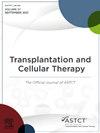Establishing a Graft-Versus-Host Disease (GVHD)-Focused Multidisciplinary Telehealth Clinic
IF 3.6
3区 医学
Q2 HEMATOLOGY
引用次数: 0
Abstract
Graft-versus-host disease (GVHD) is a complication following allogeneic hematopoietic cell transplant that frequently causes multiorgan affection and decrease in quality of life. Global assessment and care of these patients require a multidisciplinary approach, but access to focused clinics is limited given their scarcity and location in major cities, as well as mobility and transportation challenges that frequently affect these patients. Thus, we established a multispecialty GVHD telehealth (TH) clinic and hypothesized that a virtual platform will expand access to clinical care in children and adults. The clinic team members included BMT specialist, nursing, dermatologist, dentist, nutritionist, physiatrist, research personnel, and others as needed. We evaluated all GVHD-related visits (in-person and TH) conducted in a single center from 01/2022 to 12/2022. Ninety-three patients received a total of 308 visits, and one-third were via TH. Approximately half of the in-person group had at least 1 TH visit, and 10 patients were seen exclusively via TH. Most patients had advanced chronic GVHD. More male patients were seen in GVHD clinic, but female patients had increased in clinic visits via TH (41% TH versus 32% in-person). One-third of clinic visits were from patients of racial and ethnic minorities. While only 6% (n = 12/217) of in-person visits were for patients living >100 miles from the center, 34% (n = 31/91) of TH visits were from far distances including out-of-state. At baseline, the most common patient-reported symptoms in a subset of patients included fatigue, disturbed sleep, and distress. Fifteen patients completed a follow-up symptom survey and reported significantly reduced distress regarding their GVHD (P = .02), although other symptoms remained stable. A multidisciplinary TH clinic provided care for adult and pediatric patients with GVHD. We demonstrated preliminary feasibility of building a robust TH platform with a collaborative multispecialty approach that allowed access and continuity of medical care. Gender inequalities were reduced, and distance to our center represented a lesser barrier to attending specialized care via TH. Additionally, patients reported a significant reduction in distress. Our findings support the ongoing development of a virtual platform to improve access to specialized GVHD care.
建立以移植物抗宿主病(GVHD)为重点的多学科远程医疗诊所。
移植物抗宿主疾病(GVHD)是异基因造血细胞移植(allo-HCT)后的一种并发症,经常导致多器官损伤和生活质量下降。对这些患者进行全面评估和护理需要采用多学科方法,但由于集中诊所数量稀少且位于大城市,再加上这些患者经常面临行动和交通不便的挑战,因此前往集中诊所就诊的机会非常有限。因此,我们建立了一个多专科 GVHD 远程医疗(TH)诊所,并假设虚拟平台将扩大儿童和成人临床护理的可及性。诊所团队成员包括 BMT 专家、护理人员、皮肤科医生、牙医、营养师、理疗师、研究人员以及其他需要的人员。我们评估了从 2022 年 1 月 1 日至 2022 年 12 月 12 日在一个中心进行的所有 GVHD 相关就诊(面对面和 TH)。93名患者共接受了308次就诊,其中三分之一是通过TH就诊。约一半的亲诊患者至少接受过一次 TH 治疗,10 名患者完全通过 TH 就诊。大多数患者为晚期慢性乙型肝炎。在 GVHD 诊所就诊的男性患者较多,但女性患者通过 TH 就诊的比例有所上升(41% 的患者通过 TH 就诊,32% 的患者亲自就诊)。三分之一的门诊就诊者为少数民族患者。虽然仅有 6% (12/217)的亲诊患者居住在距离中心 100 英里以上的地方,但 34% (31/91)的 TH 就诊患者来自很远的地方,包括州外。基线时,患者报告的最常见症状包括疲劳、睡眠不安和痛苦。有 15 名患者完成了后续症状调查,并报告说他们对 GVHD 的痛苦明显减轻(p= 0.02),但其他症状仍保持稳定。一个多学科TH诊所为成人和儿童GVHD患者提供治疗。我们初步证明了通过多专科协作的方式建立一个强大的创伤治疗平台的可行性,该平台允许患者获得医疗服务并保持医疗服务的连续性。性别不平等现象有所减少,距离我们中心的距离也减少了通过 TH 接受专科治疗的障碍。此外,据患者报告,他们的痛苦明显减少。我们的研究结果支持目前正在进行的虚拟平台开发,以改善 GVHD 专科护理的可及性。
本文章由计算机程序翻译,如有差异,请以英文原文为准。
求助全文
约1分钟内获得全文
求助全文
来源期刊

Transplantation and Cellular Therapy
Medicine-Hematology
CiteScore
7.00
自引率
15.60%
发文量
1061
审稿时长
51 days
 求助内容:
求助内容: 应助结果提醒方式:
应助结果提醒方式:


